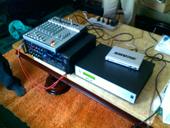On occasion, document sight translation is required of the interpreter during consecutive interpretation work. Sight translation combines interpretation and translation; the interpreter must read aloud the source-language document to the target-language as if it were written in the target language. Sight translation occurs usually, but not exclusively, in judicial and medical work.
Consecutively-interpreted speeches, or segments of them, tend to be short. Fifty years ago, the CI interpreter would render speeches of 20 or 30 minutes; today, 10 or 15 minutes is considered too long, particularly since audiences don't like to sit through 20 minutes of speech they cannot understand.
Often, if not previously advised, the source-language speaker is unaware that he or she may speak more than a single sentence before the CI interpretation is rendered and might stop after each sentence to await its target-language rendering. Sometimes, however, depending upon the setting or subject matter, and upon the interpreter's capacity to memorize, the interpreter may ask the speaker to pause after each sentence or after each clause. Sentence-by-sentence interpreting requires less memorization and therefore lower likelihood for omissions, yet its disadvantage is in the interpreter's not having heard the entire speech or its gist, and the overall message is sometimes harder to render both because of lack of context and because of interrupted delivery (for example, imagine a joke told in bits and pieces, with breaks for translation in between). This method is often used in rendering speeches, depositions, recorded statements, court witness testimony, and medical and job interviews, but it is usually best to complete a whole idea before it is interpreted.
Full (i.e., unbroken) consecutive interpreting of whole thoughts allows for the full meaning of the source-language message to be understood before the interpreter renders it in the target language. This affords a truer, more accurate, and more accessible interpretation than does simultaneous interpretation.
Whispered interpreting
In whispered interpreting (chuchotage, in French), the interpreter sits or stands next to the small target-language audience whilst whispering a simultaneous interpretation of the matter to hand; this method requires no equipment. Chuchotage is used in circumstances where the majority of a group speaks the source language, and a minority (ideally no more than three persons) do not speak it.
Relay interpreting
Relay interpreting occurs when several languages are the target-language. A source-language interpreter renders the message to a language common to every interpreter, who then renders the message to his or her specific target-language. For example, a Japanese source message first is rendered to English to a group of interpreters, then it is rendered to Arabic, French, and Russian, the other target-languages.
Liaison interpreting
Liaison interpreting involves relaying what is spoken to one, between two, or among many people. This can be done after a short speech, or consecutively, sentence-by-sentence, or as chuchotage (whispering); aside from note taken then, no equipment is used.
At Shining Path Conference Solutions, you are assured of any kind of these services. We carefully screen our interpreters to ensure that you get the service you deserve. Organizing a conference is a costly affair since delegates have to be flown in from different parts of the globe, their accommodation, per diems, etc paid for by the organization. Please do no gamble! . Kindly contact us for a quote since we guarantee you value for money and our costs are very reasonable while offering you an excellent service. Contact us today for quote!





